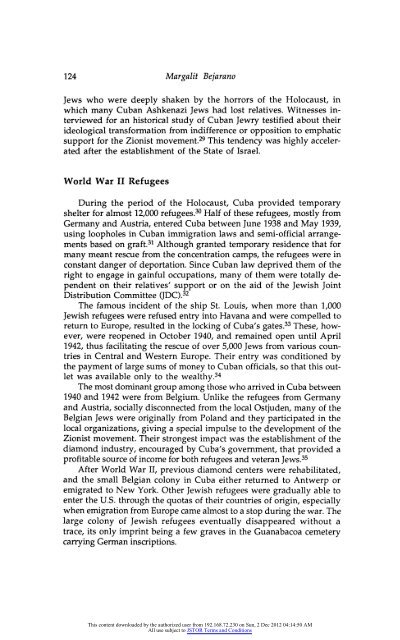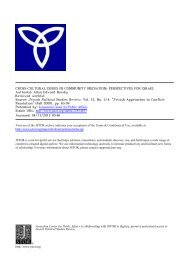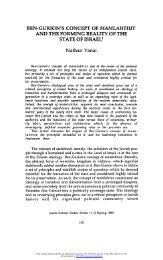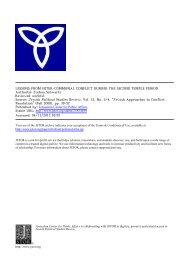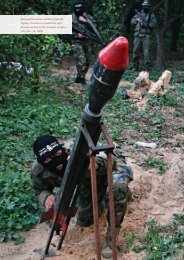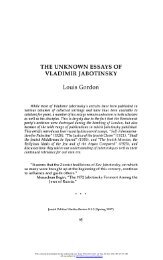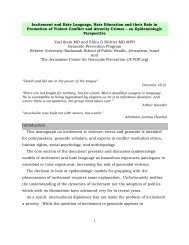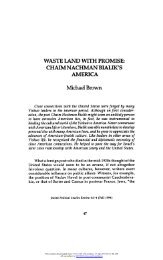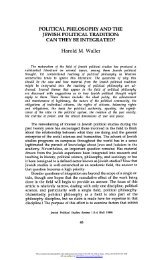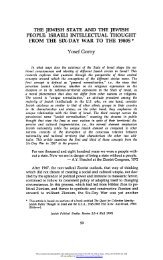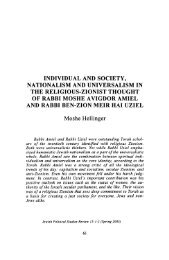the jewish community of cuba: between continuity and extinction
the jewish community of cuba: between continuity and extinction
the jewish community of cuba: between continuity and extinction
Create successful ePaper yourself
Turn your PDF publications into a flip-book with our unique Google optimized e-Paper software.
124 Margalit BejaranoJews who were deeply shakenby <strong>the</strong> horrors <strong>of</strong> <strong>the</strong> Holocaust, inwhich many Cuban Ashkenazi Jews had lost relatives. Witnesses interviewed for an historical study <strong>of</strong> Cuban Jewrytestified about <strong>the</strong>irideologicaltransformation from indifference or oppositionto emphaticsupport for <strong>the</strong> Zionist movement.29 This tendencywashighly accelerated after <strong>the</strong> establishment <strong>of</strong> <strong>the</strong> State <strong>of</strong> Israel.World War II RefugeesDuring <strong>the</strong> period <strong>of</strong> <strong>the</strong> Holocaust, Cuba provided temporaryshelter for almost 12,000 refugees.30Half <strong>of</strong> <strong>the</strong>se refugees, mostlyfromGermany<strong>and</strong> Austria, entered Cuba <strong>between</strong> June 1938 <strong>and</strong> May 1939,using loopholesin Cubanimmigrationlaws <strong>and</strong> semi-<strong>of</strong>ficial arrangements based on graft.31 Although granted temporary residence that formany meant rescue from <strong>the</strong> concentration camps, <strong>the</strong> wererefugeesinconstant danger <strong>of</strong> deportation. Since Cuban law deprived<strong>the</strong>m <strong>of</strong> <strong>the</strong>right to engage in gainful occupations, many <strong>of</strong> <strong>the</strong>m weretotally dependenton <strong>the</strong>ir relatives' supportor on <strong>the</strong> aid <strong>of</strong> <strong>the</strong> Jewish JointDistribution Committee (JDC).32The famous incident <strong>of</strong> <strong>the</strong> ship St. Louis, when more than 1,000Jewish refugees were refused entry into Havana <strong>and</strong> were compelledtoreturn to Europe, resulted in <strong>the</strong> locking<strong>of</strong> Cuba's gates 33 These, however, werereopenedin October 1940, <strong>and</strong> remained open until April1942, thus facilitating<strong>the</strong> rescue <strong>of</strong> over 5,000 Jews from various countries in Central <strong>and</strong> Western Europe. Their entrywas conditionedby<strong>the</strong> payment <strong>of</strong> largesums <strong>of</strong> money to Cuban <strong>of</strong>ficials, so that this outlet was available only to <strong>the</strong> wealthy.34The most dominant group among those who arrived in Cuba <strong>between</strong>1940 <strong>and</strong> 1942 were from Belgium.Unlike <strong>the</strong> refugeesfrom Germany<strong>and</strong> Austria, socially disconnected from <strong>the</strong> local Ostjuden, many <strong>of</strong> <strong>the</strong>Belgian Jews were originallyfrom Pol<strong>and</strong> <strong>and</strong> <strong>the</strong>y participatedin <strong>the</strong>local organizations,a giving special impulseto <strong>the</strong> development <strong>of</strong> <strong>the</strong>Zionist movement. Their strongest impactwas <strong>the</strong> establishment <strong>of</strong> <strong>the</strong>diamondindustry, encouraged by Cuba's government, that providedapr<strong>of</strong>itable source <strong>of</strong> income for both refugees <strong>and</strong> veteran Jews 35After World War II, previous diamond centers were rehabilitated,<strong>and</strong> <strong>the</strong> small Belgian colonyin Cuba ei<strong>the</strong>r returned to Antwerporemigratedto New York. O<strong>the</strong>r Jewish refugees were graduallyable toenter <strong>the</strong> U.S.through <strong>the</strong> quotas <strong>of</strong> <strong>the</strong>ir countries <strong>of</strong> origin, especiallywhenemigration from Europecame almost to a stop during<strong>the</strong> war. Thelarge colony<strong>of</strong> Jewish refugees eventually disappearedwithout atrace, its only imprint beinga few graves in <strong>the</strong> Guanabacoa cemeterycarrying German inscriptions.This content downloaded by <strong>the</strong> authorized user from 192.168.72.230 on Sun, 2 Dec 2012 04:14:50 AMAll use subject to JSTOR Terms <strong>and</strong> Conditions


